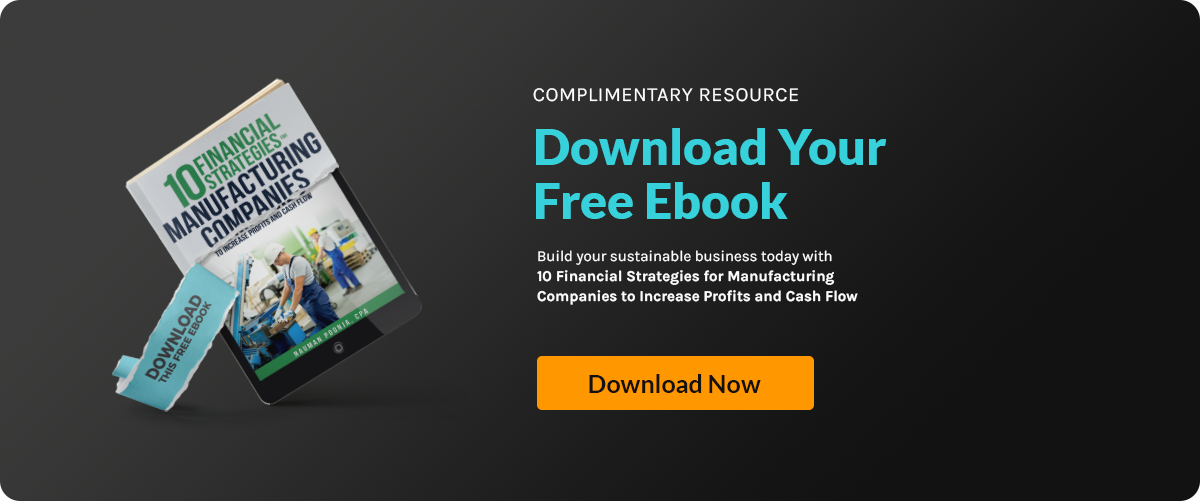In today’s connected production environments, cybersecurity is no longer an IT problem — it's a...
How to Implement Financial Controls to Prevent Fraud in Your Business
Fraud can quietly erode the financial health of a business—especially in manufacturing, where complex operations and large transaction volumes leave room for manipulation. Implementing strong financial controls helps close these gaps, reducing the risk of internal fraud while increasing transparency and accountability across the organization.
Manufacturers, in particular, face unique risks due to decentralized purchasing, inventory handling, and vendor relationships. Without clearly defined financial oversight, small missteps or deliberate misdeeds can snowball into serious financial consequences.
Why Financial Controls Are Crucial in Manufacturing
Financial controls are structured practices and procedures that help safeguard assets and maintain the integrity of financial reporting. Without them, it becomes easier for errors and intentional misstatements to go unnoticed. In manufacturing, this is particularly relevant when managing vendor payments, payroll, and physical inventory.
What Is a Baseline Fraud Risk Assessment?
A baseline fraud risk assessment is an organized review that helps manufacturers—and organizations of all stripes—shine a spotlight on their most vulnerable areas. It involves systematically analyzing current processes, policies, and transaction points to pinpoint exactly where fraud is most likely to slip through the cracks.
By mapping out high-risk zones—like decentralized purchasing or manual inventory management—leaders can recognize weak spots before they become costly problems. This proactive approach makes it much easier to adjust internal controls, close loopholes, and create clearer, more robust anti-fraud policies.
Ultimately, a baseline assessment lays the foundation for ongoing vigilance. With a clear picture of where risks reside, manufacturers can focus their efforts where they're needed most and set the stage for more resilient, transparent operations.
The Fraud Triangle: Understanding the Drivers Behind Fraudulent Behavior
One essential concept when evaluating the risk of fraud in manufacturing is the Fraud Triangle. Developed by criminologist Donald Cressey, the Fraud Triangle outlines the three primary factors that typically converge to enable fraudulent activity:
- Pressure: This is the motivation or incentive that drives an individual to commit fraud. In manufacturing settings, pressure might arise from meeting financial targets, personal financial difficulties, or unrealistic production goals.
- Opportunity: Weak or poorly enforced internal controls provide the opening that would-be fraudsters need. Decentralized processes, inadequate segregation of duties, or insufficient oversight can unintentionally create these opportunities.
- Rationalization: This factor reflects how someone justifies unethical behavior. It often takes the form of self-talk like, “I deserve this,” or “It’s only temporary.” When individuals can rationalize their actions, they’re more likely to act on available opportunities and pressures.
Understanding the Fraud Triangle helps manufacturers identify where their control systems might fall short—and where improvements can reduce the risk of fraudulent activity going unnoticed. By reinforcing policies and procedures at each point of the triangle, organizations can better protect themselves from internal threats.
Poor inventory tracking, for instance, can directly lead to financial distortion. Unaccounted-for shrinkage, inflated ordering, or overproduction can tie up working capital and increase overhead. These inefficiencies often manifest as higher inventory carrying costs, directly impacting the bottom line—and creating fertile ground for fraud to go undetected.
Fraud-related risks don’t stop with inventory. They extend into vendor relationships, payment approvals, and even capital expenditures. The absence of proper controls in any of these areas increases exposure.
Core Controls That Reduce the Risk of Fraud
1. Segregation of Duties
Dividing responsibilities among team members prevents a single person from having unchecked control over financial processes. For instance, the individual approving a purchase should not be the one recording or receiving it. This segregation creates internal accountability and reduces the risk of intentional wrongdoing.
When paired with automation, segregation becomes even more effective. Many forward-thinking manufacturers are already implementing accounting automation to enforce role-based access and oversight rules.
2. Controlled Approval Workflows
Introducing tiered approval workflows—especially for large transactions—adds a layer of verification. Changes to vendor details, unusual expense patterns, or rushed payments can all be flagged and reviewed before execution, preventing common fraud tactics like vendor impersonation or inflated billing.
Standardizing workflows also improves efficiency by ensuring that approvals don’t become bottlenecks. When digitized, these workflows allow for full traceability of who approved what and when.
3. Consistent Reconciliations
Reconciliations help validate that your records accurately reflect real-world transactions. By comparing internal ledgers with bank statements, supplier invoices, and physical inventories, discrepancies can be caught early and addressed before they escalate into larger issues.
This practice is also essential for managing cash flow effectively. Regular reviews can uncover timing differences, duplicate payments, or overlooked credits—each of which affects liquidity and decision-making.
To maximize effectiveness, reconciliations should be performed consistently and documented clearly. Internal audits—whether conducted in-house or with outside experts—help identify process weaknesses and recommend improvements. Periodic employee evaluations can also offer insight into potential fraud risk, especially when viewed through factors like job satisfaction, workload, and morale.
4. Technology-Driven Monitoring
As companies grow, manual monitoring becomes impractical. Financial planning and analysis (FP&A) tools offer centralized dashboards, anomaly detection, and real-time alerts. These features support faster decision-making and reduce the chance of fraudulent activity slipping through the cracks.
More importantly, when you streamline the financial planning process, you're not just forecasting better—you’re creating the infrastructure to catch irregularities before they become threats.
5. Proactive Cybersecurity Scanning
Regular cybersecurity scans—both internal and external—act as an essential line of defense against digital fraudsters. By routinely checking your networks, devices, and applications for vulnerabilities, you’re much more likely to spot gaps before a bad actor does. This proactive monitoring helps uncover weaknesses in firewalls, outdated software, or employee credentials that may have been compromised in a breach.
Whether managed by your in-house IT team with tools like Nessus and Qualys or handled by a trusted third-party provider, these scans should be scheduled and actionable. The key is making security part of daily operations, not an afterthought—so questionable system activity and unauthorized access can be detected early, long before they escalate into financial losses or reputational damage.
Supporting Fraud Prevention Through Culture
While processes and tools are vital, culture plays a pivotal role in sustaining fraud prevention. Organizations that prioritize transparency, accountability, and ethical behavior tend to experience fewer incidents of internal fraud.
Encourage open communication where employees feel safe reporting irregularities. Offer fraud-awareness training, and make sure your code of conduct is more than just a formality. Leadership should model the integrity they expect from others.
Additionally, regular internal audits can help reinforce a culture of compliance. When staff understand that reviews are routine and constructive, they become more diligent and invested in doing things the right way.
Building a Strong Fraud Prevention Framework
Effective fraud prevention goes beyond day-to-day controls—it’s about creating clear expectations, fostering transparency, and maintaining a culture of accountability. Three core policies provide a strong foundation:
-
Whistleblower Policy: Offers a confidential, retaliation-free way for employees to report suspected fraud or unethical behavior, enabling early intervention.
-
Conflict of Interest Policy: Requires annual disclosures and recusal from impacted decisions, ensuring transparency and protecting the integrity of business choices.
-
Information Security Policy: Establishes standards for classifying, handling, and protecting sensitive information, reducing the risk of data breaches and misuse.
Formal adoption and regular communication of these policies help embed ethical conduct into daily operations.
Customizing Controls to Your Organization
Fraud controls are most effective when tailored to your specific risks, structure, and risk tolerance. A family-owned business may benefit from simple approval limits, while a multi-site operation may require layered controls and automation. Regularly reviewing and refining these measures ensures they remain practical, relevant, and aligned with evolving risks.
Human Factors: Spotting Red Flags
Fraud risk isn’t only about weak processes—it often stems from employee behavior and workplace culture. Warning signs include:
-
Declining work ethic or inconsistent performance
-
Employees who never take vacation or exhibit unusual role attachment
-
Pay disparities that could create resentment or opportunity
-
Widespread dissatisfaction or low morale, which can increase collusion risk
Routine evaluations and open dialogue can surface these issues early, addressing them before they escalate.
Leveraging Evaluations and Audits
Performance reviews and employee check-ins provide opportunities to assess risk factors linked to the “Fraud Triangle”: pressure, opportunity, and rationalization. Complement these with regular internal audits to evaluate processes, identify vulnerabilities, and strengthen controls. Occasional external audits bring fresh perspectives and specialized expertise.
Integrating Fraud Prevention into Risk Management
Fraud prevention works best as part of a broader risk management strategy that combines policies, controls, technology, and culture. Practical steps include segregation of duties, automated workflows, timely reconciliations, and the use of analytics to detect anomalies. Proactive organizations continuously refine these measures, adapting to changes in technology, operations, and emerging fraud tactics.
Staying Ahead
Fraud schemes evolve alongside business models and technology. A forward-thinking approach—supported by robust systems, engaged leadership, and a culture of accountability—allows organizations to anticipate risks, adapt quickly, and protect both their reputation and bottom line.
Accounovation offers tailored solutions to help you creates process to prevent fraud. From systems to creating clear seperation of roles, our expert services are designed to help you prevent fraud in your organization.
Contact Accounovation today to learn how we can help your business achieve financial stability and growth.








